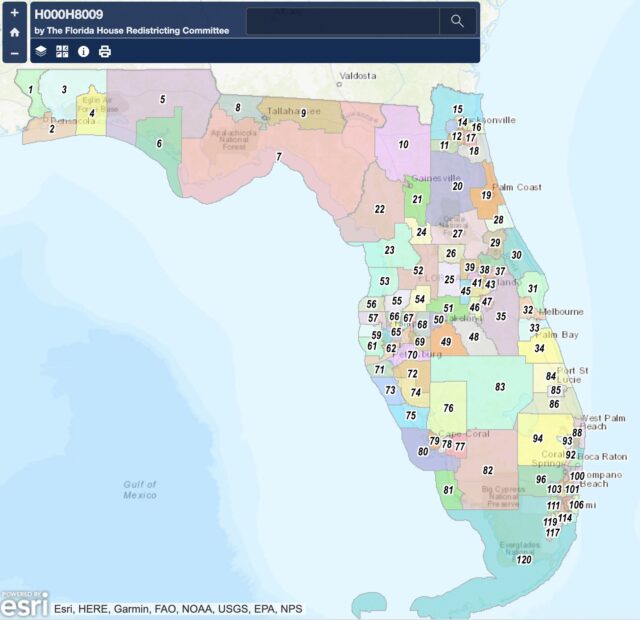
The picture of Florida’s House district boundaries for the 2022 election came further into focus Friday. The House Legislative Redistricting Subcommittee advanced a map (H 8009) on a 13-7 vote, breaking down largely along party lines.
“The state House map before you today is constitutionally compliant work. It is a constitutionally compliant work product this committee can be proud of,” said Rep. Cord Byrd, a Neptune Beach Republican and the subcommittee chair.
But Democrats expressed concerns about a process they said isn’t transparent enough and a final map that doesn’t significantly increase the number of districts likely to elect minority candidates to the state House.
Rep. Dan Daley, a Sunrise Democrat and the subcommittee’s ranking member, said the lack of interim drafts made him question if the general public or even the lawmakers involved in the process had enough say on shaping the lines.
“I do have significant heartburn still over this proposed map, and part of that stems from the fact that, you know, they dropped it Tuesday at 4:45 (p.m.),” he said. “It is a whopping couple days later and we’re already voting it out of committee. Meanwhile, this committee has been working for four months.”
There is a contrast visible between the Senate and House process. While the full Senate already passed legislative and congressional maps Thursday, the legislative subcommittee in the upper chamber discussed 12 drafts before the matter was taken up for a vote, at which point two more drafts pushed by senators were discussed.
The map advanced from the House legislative panel is the third draft published, and no amendments have been submitted or considered by representatives to date.
The map which passed out of committee became available for review Tuesday. The map settled differences in many places by picking configurations that appeared in one of two prior drafts (H 8005, H 8007).
For example, early drafts took different approaches with House District 117, a Hispanic protected district. In one draft, HD 117 was a narrow and winding districting connecting Liberty City north to Graceland South Memorial Park in Miami. The other draft imagined a rounder district that never reached as far south as Homestead and reached north only to Palmetto Bay.
The advanced map goes with the former configuration and builds nearby South Florida districts around the proposed HD 117 accordingly.
But in other areas of Florida, the map introduces new configurations unseen in either former draft.
For example, the map still splits Gainesville between House Districts 10 and 21, but creates more square districts with fewer community splits.
Some controversial elements of maps have survived all three drafts published in the House. The most notable may be a configuration of the proposed House District 62. While staff say the district serves as an analogous replacement for the existing House District 70, this district covers parts of two counties — Hillsborough and Pinellas — as opposed to the current map’s four counties. It also covers parts of Manatee and Sarasota.
Rep. Kristen Arrington, a Kissimmee Democrat, said the fact you can’t find the district and that it could take an hour and 45 minutes to drive from the Pinellas portion to the Hillsborough parts should alarm people, even if drive time isn’t a constitutional concern.
Staff cartographers said the water connection across the Bay serves as the connective tissue of the district.
A major concern of Democrats who voted against the maps Friday was a lack of minority representation. Despite the Hispanic population growth of 1.5 million people over the last decade and a half, there are no more Hispanic opportunity districts in the new plan than the baseline maps in use now.
Rep. Marie Woodson, a Hollywood Democrat, also said that while court rulings regarding prior redistricting maps require protecting voter access for language minorities, there is little account on the House map for Haitian American communities in South Florida. That’s despite the fact the House map crafted 10 years ago — the only one produced by the Florida Legislature in 2012 to survive court scrutiny — tried to create Haitian American districts.
She also noted two of the South Florida representatives for those communities — Omari Hardy and Bobby DuBose — recently resigned to run for Congress. That has left Woodson carrying much of the burden of representing the Haitian American communities’ concerns during the process.
“Was there any consideration given over the fact that there’s no representation to participate in the process? Or was there any other time maybe it was done that we are not aware so we can make sure that this is addressed in this process as well?” she said.
Ultimately, Republican leaders in the committee said the maps produced in the process will pass muster with the courts, and that should be the chief concern.
“Our charge was legally compliant maps. And we did it,” said Rep. Will Robinson, a Bradenton Republican. “I think these maps are a good product. Our charge is to follow the constitution.”
The map was advanced from the subcommittee as a proposed committee bill (PCB 22-01) with Byrd as the sponsor. It will now go before the larger House Redistricting Committee before advancing to the floor.
Byrd stressed additional concerns members may have can still be raised during that process, and amendments can still be filed.
The House and Senate must agree on legislative maps but have historically deferred to one another to craft lines for their respective chambers. These maps are not subject to approval by the Governor.



